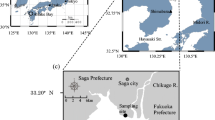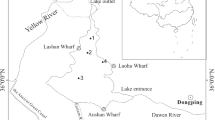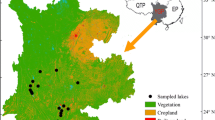Abstract
Purpose
Agricultural drainage ditches constitute corridor wetlands that facilitate agricultural non-point nitrogen (N) load transportation into river systems. Quantifying sediment denitrification in ditches provides relationships between N losses from agriculture and water quality. However, high denitrification rate potential and limited N residence time make the total denitrification removal capacity in ditches uncertain. The purpose of this work was to identify N removal by denitrification in agricultural ditches in the Taihu Lake region of China.
Materials and methods
A field investigation and laboratory analyses were conducted to investigate the sediment denitrification rate of ditches in areas under different crops, including vegetable, rice-wheat fields, and a peach orchard, between June 2014 and October 2015. At each sampling, concentrations of dissolved inorganic nitrogen (DIN, NO3 −-N, NH4 +-N), water temperature, pH, Eh, dissolved oxygen, and dissolved organic carbon of the overlying water and the DIN and total carbon of the sediment were examined.
Results and discussion
Sediment denitrification rates in all the ditches exhibited high spatial and temporal heterogeneity. Concentrations of DIN and temperature of the overlying water were key factors controlling denitrification in the ditch system. The sediment denitrification rate in the ditches could be estimated by a nonlinear mixed-effect model. Based on estimating data on N concentrations and temperature of overlying water and our established nonlinear mixed model, less than 1% of N was removed by denitrification annually in the ditches. The limited N removal by sediment denitrification was attributed to short retention times and the low area of the ditch system.
Conclusions
Dissolved inorganic nitrogen concentrations and temperature of the overlying water were key factors controlling denitrification in the ditch system. High density of ditches did not lead to high N removal by denitrification due to short retention times and low areal coverage in the Taihu Lake region.





Similar content being viewed by others
References
Alexander RB, Boyer EW, Smith RA, Schwarz GE, Moore RB (2007) The role of headwater streams in downstream water quality. J Am Water Resour Assoc 43(1):41–59
Alexander RB, Smith RA, Schwarz GE (2000) Effect of stream channel size on the delivery of nitrogen to the Gulf of Mexico. Nature 403(6771):758–761
BryantMason A, Xu YJ, Altabet MA (2013) Limited capacity of river corridor wetlands to remove nitrate: a case study on the Atchafalaya River Basin during the 2011 Mississippi River Flooding. Water Resour Res 49:283–290
Castaldelli G, Soana E, Racchetti E, Vincenzi F, Fano EA (2015) Vegetated canals mitigate nitrogen surplus in agricultural watersheds. Agric Ecosyst Environ 212:253–262
Gao C, Zhu JG, Zhu JY, Gao X, Dou YJ, Hosen Y (2004) Nitrogen export from an agriculture watershed in the Taihu Lake area, China. Environ Geochem Health 26(2–3):199–207
Guntinas ME, Leiros MC, Trasar-Cepeda C, Gil-Sotres F (2012) Effects of moisture and temperature on net soil nitrogen mineralization: a laboratory study. Eur J Soil Biol 48:73–80
Jain CK, Bhatia KKS, Seth SM (1998) Assessment of point and non-point sources of pollution using a chemical mass balance approach. Hydrol Sci J 43(3):379–390
Johnes PJ, Heathwaite AL (1997) Modelling the impact of land use change on water quality in agricultural catchments. Hydrol Process 11(3):269–286
Ju XT, Xing GX, Chen XP, Zhang SL, Zhang LJ, Liu XJ, Cui ZL, Yin B, Christie P, Zhu ZL, Zhang FS (2009) Reducing environmental risk by improving N management in intensive Chinese agricultural systems. Proc Natl Acad Sci U S A 106:3041–3046
Kim M, Boithias L, Cho KH, Silvera N, Thammahacksa C, Latsachack K, Rochelle-Newall E, Sengtaheuanghoung O, Pierret A, Pachepsky YA, Ribolzi O (2017) Hydrological modeling of Fecal Indicator Bacteria in a tropical mountain catchment. Water Res 119:102–113
Kreiling RM, Richardson WB, Cavanaugh JC, Bartsch LA (2011) Summer nitrate uptake and denitrification in an upper Mississippi River backwater lake: the role of rooted aquatic vegetation. Biogeochemistry 104(1–3):309–324
Li XB, Xia YQ, Li YF, Kana TM, Kimura SD, Saito M, Yan XY (2013) Sediment denitrification in waterways in a rice-paddy-dominated watershed in eastern China. J Soils Sediments 13:783–792
Liu X, Li D, Zhang H, Cai S, Li X, Ao T (2015) Research on nonpoint source pollution assessment method in data sparse regions: a case study of Xichong River basin, China. Adv Meteorol 519671:1–10. http://dx.doi.org/10.1155/2015/519671
Misiti TM, Hajaya MG, Pavlostathis SG (2011) Nitrate reduction in a simulated free-water surface wetland system. Water Res 45(17):5587–5598
Ni WZ, Li JP, Zhu ZL (2007) Occurrence of nitrification-denitrification and gaseous nitrogen loss process in flooded rice soil. Prog Nat Sci 17:6–10
Novotny V, Wang X, Englande AJ Jr, Bedoya D, Promakasikorn L, Tirado R (2010) Comparative assessment of pollution by the use of industrial agricultural fertilizers in four rapidly developing Asian countries. Environ Dev Sustain 12(4):491–509
Peterson BJ, Wollheim WM, Mulholland PJ, Webster JR, Meyer JL, Tank JL, Martí E, Bowden WB, Valett HM, Hershey AE, McDowell WH, Dodds WK, Hamilton SK, Gregory S, Morrall DD (2001) Control of nitrogen export from watersheds by headwater streams. Science 292(5514):86–90
Pfenning KS, McMahon PB (1997) Effect of nitrate, organic carbon, and temperature on potential denitrification rates in nitrate-rich riverbed sediments. J Hydrol 187(3–4):283–295
Qin B, Xu P, Wu Q, Luo L, Zhang Y (2007) Environmental issues of Lake Taihu, China. Hydrobiologia 581:3–14
Sala OE, Chapin FS, Armesto JJ, Berlow E, Loomfield B, Dirzo R, Huber-Sanwald E, Huenneke LF, Jackson RB, Kinzig A, Leemans R, Lodge DM, Mooney HA, Oesterheld M, Poff NL, Sykes MT, Walker BH, Walker M, Wall DH (2000) Global biodiversity scenarios for the year 2100. Science 287(5459):1770–1774
Seitzinger SP, Nielsen LP, Caffrey J, Christensen PB (1993) Denitrification measurements in aquatic sediments: a comparison of three methods. Biogeochemistry 23:147–167
Smith LK, Voytek MA, Böhlke JK, Harvey JW (2006) Denitrification in nitrate-rich streams: application of N2: Ar and 15N-tracer methods in intact cores. Ecol Appl 16(6):2191–2207
Stevens CJ, Dice NB, Mountford JO, Gowing DJ (2004) Impact of nitrogen deposition on the species richness of grasslands. Science 303(5665):1876–1879
Terry RE, Tate RL, Duxbury JM (1981) The effect of flooding on nitrous oxide emissions from an organic soil. Soil Sci 132:228–232
Xia Y, Li Y, Li X, Guo M, She D, Yan X (2013) Diurnal pattern in nitrous oxide emissions from a sewage-enriched river. Chemosphere 92(4):421–428
Xing GX, Zhu ZL (2001) The environmental consequences of altered nitrogen cycling resulting from industrial activity, agricultural production, and population growth in China. Sci World J 1:70–80
Xing GX, Zhu ZL (2002) Regional nitrogen budgets for China and its major watersheds. Biogeochemistry 57:405–427
Yu KW, DeLaune RD, Boeckx P (2006) Direct measurement of denitrification activity in a Gulf coast freshwater marsh receiving diverted Mississippi River water. Chemosphere 65(11):2449–2455
Zhao YQ, Xia YQ, Li BL, Yan XY (2014) Influence of environmental factors on net N2 and N2O production in sediment of freshwater rivers. Environ Sci Pollut Res Int 21(16):9973–9982
Zhao YQ, Xia YQ, Ti CP, Shan J, Li BL, Xia LL, Yan XY (2015) Nitrogen removal capacity of the river network in a high nitrogen loading region. Environ Sci Technol 49(3):1427–1435
Zhong XY, Yang HS, Zhao LQ, Han JD (1999) Study on dynamic of N and P in the Changjiang estuary (in Chinese). J Fish Sci China 6:6–9
Funding
We acknowledge and are grateful for the financial support provided by the Natural Science Foundation of Jiangsu Province (BK20161503); the National Nature Science Foundation of China (41471238, 51779245); the Open Funding Project (No. Y412201423) of the State Key Laboratory of Soil and Sustainable Agriculture (Institute of Soil Science, Chinese Academy of Sciences); the Qing Lan Project of Jiangsu Province; and the Priority Academic Program Development of Jiangsu Higher Education Institutions (PAPD).
Author information
Authors and Affiliations
Corresponding authors
Additional information
Responsible editor: Haihan Zhang
Electronic supplementary material
ESM 1
(DOCX 897 kb)
Rights and permissions
About this article
Cite this article
She, D., Zhang, L., Gao, X. et al. Limited N removal by denitrification in agricultural drainage ditches in the Taihu Lake region of China. J Soils Sediments 18, 1110–1119 (2018). https://doi.org/10.1007/s11368-017-1844-8
Received:
Accepted:
Published:
Issue Date:
DOI: https://doi.org/10.1007/s11368-017-1844-8




